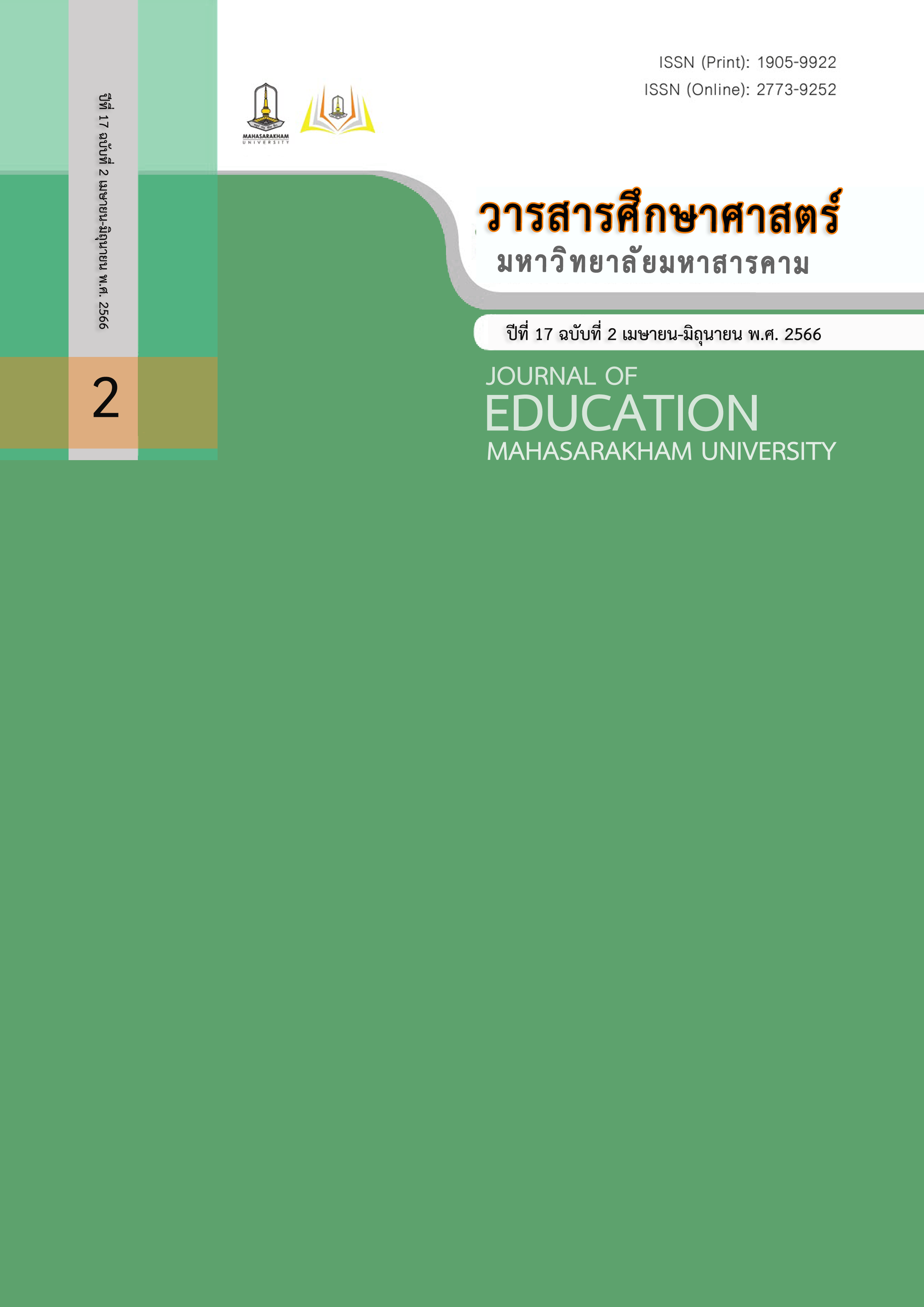The Relationship between Strategic Leadership of School Administrators and Effectiveness of World-Class Standard Schools Under The Secondary Educational Service Area Office Chaiyaphum
Main Article Content
Abstract
The purposes of this research were 1) to study the level of strategic leadership of school administrators and the level of effectiveness of school administrators in World-Class Standard Schools, 2) to study the relationship between strategic leadership of school administrators and effectiveness of World-Class Standard Schools, and 3) to study the strategic leadership affecting the effectiveness of World-Class Standard Schools, under the Secondary Educational Service Area Office Chaiyaphum. The sample used in this study consisted of administrators and teachers. The sample size of 458 was determined by using Krejcie & Morgan’s formula and stratified random sampling technique. The research instrument used in this study was a 85 items of 5-point rating scale questionnaire with an index of congruence between 0.8 - 1.0 and the range of the confidence value was .989. The statistics used for the data analysis were mean, standard deviation, Pearson’s Product-Moment correlation coefficient, and stepwise multiple regression analysis.
Findings showed that;
1) The level of strategic leadership of school administrators was at the highest level, and the level of effectiveness of school administrators in World-Class Standard Schools, was at the high level. 2) The relationship between strategic leadership of school administrators and effectiveness of World-Class Standard Schools under the Secondary Educational Service Area Office Chaiyaphum, according to the opinions of teachers for overall revealed a high correlation (r = .722) at the significance level of .05. 3) There were four aspects of strategic leadership affecting the effectiveness of World-Class Standard Schools consisting of the control and evaluation (X3), the organizational direction of the strategy (X1), the implementation of the strategy (X2), and the organizational culture development (X4). The predictive coefficient or predictive power was 53.2 at the significance level of .05. The construction of the equation in standardized and unstandardized scores were as followed:
Y = .286 + .338 (X3) + .268 (X1) + .184 (X2) + .126 (X4)
Z = .306 (ZX3) +.231 (ZX1) +.166 (ZX2) + .111 (ZX4)
Downloads
Article Details

This work is licensed under a Creative Commons Attribution-NonCommercial-NoDerivatives 4.0 International License.
References
ณิรดา เวชญาลักษณ์. (2560). ภาวะผู้นำทางการบริหาร. กรุงเทพฯ: สำนักพิมพ์แห่งจุฬาลงกรณ์มหาวิทยาลัย.
นัฐชา แลบัว และกุลจิรา รักษนคร. (2566). ความสัมพันธ์ระหว่างภาวะผู้นำเชิงสร้างสรรค์ของผู้บริหารสถานศึกษาและประสิทธิผลของสถานศึกษา สังกัดสำนักงานเขตพื้นที่การศึกษาประถมศึกษาสระบุรี เขต 1. วารสารศึกษาศาสตร์ มหาวิทยาลัยสารคาม, 17(1), 120-134.
บุญชม ศรีสะอาด. (2554). การวิจัยเบื้องต้น. พิมพ์ครั้งที่ 9. กรุงเทพมหานคร: สุริยาสาส์น.
ภารดี อนันต์นาวี. (2553). หลักการ แนวคิด ทฤษฎีทางการบริหารการศึกษา. พิมพ์ครั้งที่ 3. ชลบุรี : มนตรี.
รื่น หมื่นโกตะ. (2557). กระบวนการวางแผนกลยุทธ์ในการบริหารการเปลี่ยนแปลงของผู้บริหารโรงเรียนมัธยมศึกษาในโครงการโรงเรียนมาตรฐานสากล. ปริญญาศึกษาศาสตรดุษฎีบัณฑิต สาขาวิชาการบริหารการศึกษาและผู้นำการเปลี่ยนแปลง มหาวิทยาลัยอีสเทิร์นเอเชีย.
วิรันทร์รัตน์ เสือจอย. (2564). ภาวะผู้นำเชิงกลยุทธ์ของผู้บริหารสถานศึกษาที่ส่งผลต่อคุณภาพผู้เรียนของโรงเรียน สังกัดสำนักงานเขตพื้นที่การศึกษามัธยมศึกษาสิงห์บุรีอ่างทอง. วิทยานิพนธ์ปริญญาศึกษาศาสตรมหาบัณฑิต สาขาวิชาการบริหารการศึกษา มหาวิทยาลัยศิลปากร
สำนักงานเขตพื้นที่การศึกษามัธยมศึกษาชัยภูมิ. (2565). แผนปฏิบัติการประจำปีงบประมาณ พ.ศ. 2565. สำนักงานเขตพื้นที่การศึกษามัธยมศึกษาชัยภูมิ : สำนักงานเขตพื้นที่การศึกษามัธยมศึกษาชัยภูมิ.
สำนักบริหารงานการมัธยมศึกษาตอนปลาย. (2561). แนวทางการดำเนินงานโรงเรียนมาตรฐานสากล (ปรับปรุง). กรุงเทพฯ : โรงพิมพ์ชุมนุมสหกรณ์การเกษตรแห่งประเทศไทย.
สุกัญญา เตจ๊ะ. (2564). ความสัมพันธ์ระหว่างภาวะผู้นำการเปลี่ยนแปลงของผู้บริหารสถานศึกษากับประสิทธิผลของโรงเรียนมาตรฐานสากล สังกัดสำนักงานเขตพื้นที่การศึกษามัธยมศึกษา เขต 36. วิทยานิพนธ์ปริญญาการศึกษามหาบัณฑิต สาขาวิชาการบริหารการศึกษา มหาวิทยาลัยพะเยา.
สุชาวลี ทองโพธิ์ใหญ่. (2566). ภาวะผู้นำเชิงกลยุทธ์ของผู้บริหารสถานศึกษาที่ส่งผลต่อประสิทธิผลของสถานศึกษา สังกัดสำนักงานเขตพื้นที่การศึกษามัธยมศึกษาอุดรธานี. วารสารสาขามนุษยศาสตร์และสังคมศาสตร์ มหาวิทยาลัยมหาจุฬาลงกรณราชวิทยาลัย วิทยาเขตขอนแก่น, 9(1), 1-14.
สุทธิชัย นาคะอินทร์. (2561). รูปแบบความสัมพันธ์โครงสร้างเชิงเส้นของภาวะผู้นำเชิงสร้างสรรค์ของผู้บริหารสถานศึกษาที่ส่งผลต่อประสิทธิผลของโรงเรียน สังกัดสำนักงานเขตพื้นที่การศึกษามัธยมศึกษา เขต 23. วิทยานิพนธ์ปริญญาครุศาสตรมหาบัณฑิต สาขาวิชาการ บริหารการศึกษา บัณฑิตวิทยาลัย มหาวิทยาลัยราชภัฏสกลนคร.แห่งประเทศไทย.
หัสรินทร์ ดอนดี. (2564). ปัจจัยการบริหารสถานศึกษาที่มีความสัมพันธ์กับประสิทธิผลการปฏิบัติงานของครูในโรงเรียนมาตรฐานสากล จังหวัดลำปาง สังกัดสำนักงานเขตพื้นที่การศึกษามัธยมศึกษา เขต 35. วิทยานิพนธ์ปริญญาศึกษาศาสตรมหาบัณฑิต สาขาวิชาการบริหารการศึกษา มหาวิทยาลัยเนชั่น.
Bailey, C. (2007). Abstract. The Meaning, Antecedents and Outcomes of Employee Engagement: A Narrative Synthesis. International Journal of Management Reviews, 1, 1-23.
Davies, B. & Davies, B.J.(2010). The nature and dimensions of strategic leadership. International Studies in Educational Administration, 38 (1), 5-21.
Dubrin, A.J. (2004). Leadership: Research Findings, Practice and Skills. 4 th ed.New York: McGraw - Hill.
Jonson, G. & Scholes, K. (2003). Explore Cooperate Strategy. Prentics Hall.
Kinicki, A., & Williams, B. (2009). Management 3/e. New York: McGraw-Hill.
Schemerhorn, J.R. (1999). Management, 6th ed. New York: John Wiley & Sons.


